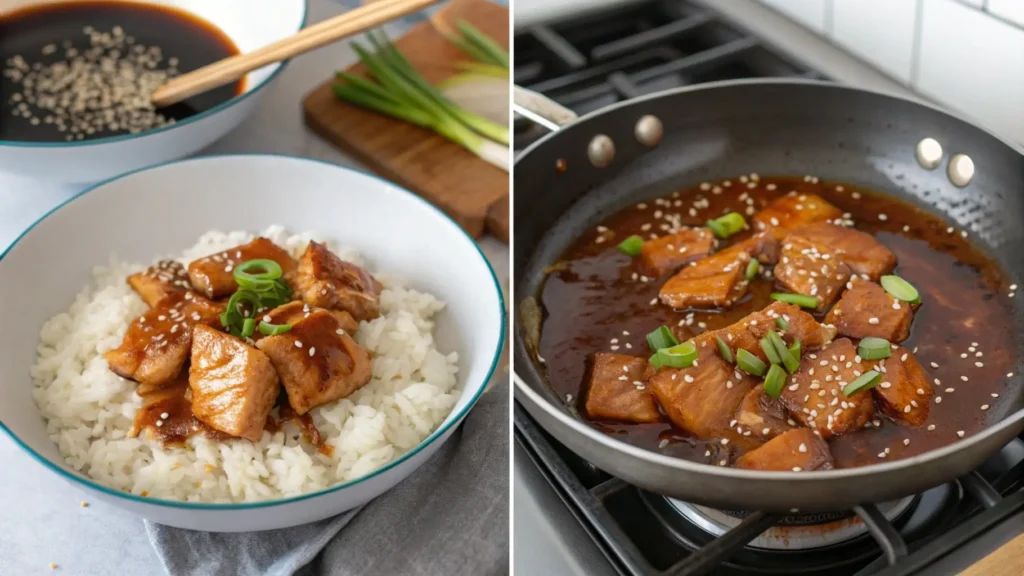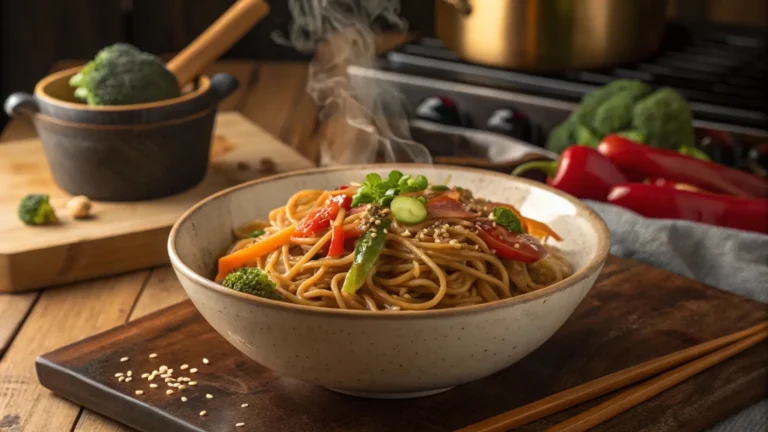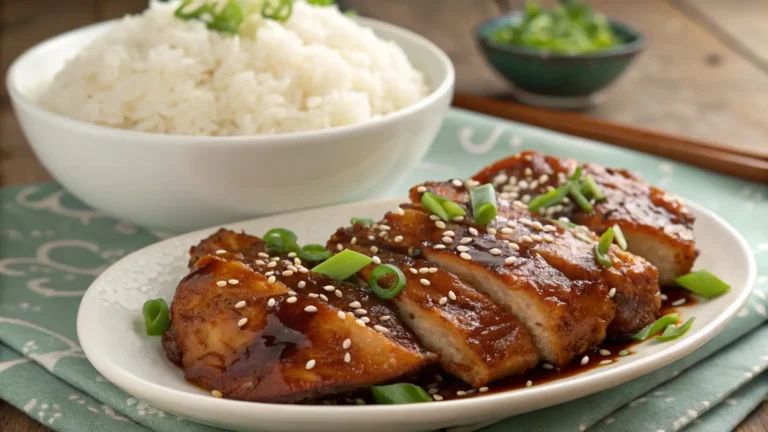Is Chicken Teriyaki Healthy to Eat? Benefits and Facts
Chicken teriyaki is a dish loved worldwide for its sweet and savory flavor, tender meat, and versatility. Whether it’s served with rice, steamed veggies, or noodles, it’s a staple in many diets. But is it really healthy? That’s the big question.

In this article, we’ll take a deep dive into chicken teriyaki, examining its nutritional profile, health benefits, potential downsides, and how it fits into different diets. By the end, you’ll know exactly how to enjoy this dish in a way that aligns with your health goals.
Let’s kick things off by understanding what makes chicken teriyaki so special.
What Is Chicken Teriyaki?
The Origins of Chicken Teriyaki
Chicken teriyaki hails from Japan, where “teriyaki” refers to a cooking technique. The word itself combines “teri,” meaning luster or shine, and “yaki,” meaning grilled or broiled. Traditional teriyaki sauce, made with soy sauce, mirin, sugar, and sake, coats the meat, giving it that glossy, caramelized finish.
Originally, this method was used for fish, but over time, chicken teriyaki became popular, especially in Westernized versions of Japanese cuisine.
Traditional Preparation and Ingredients
Authentic chicken teriyaki is a straightforward dish. The chicken, usually thigh meat, is marinated in a mix of soy sauce, mirin, sugar, and sake. It’s then grilled, broiled, or pan-fried until perfectly tender and coated with a sticky, umami-rich sauce.
However, modern variations often include additional ingredients like garlic, ginger, or even pineapple juice for a tangy twist. In restaurants, teriyaki sauce might also include thickeners, preservatives, or added sugars.
Variations Across the Globe
As chicken teriyaki gained popularity worldwide, it evolved. In the U.S., it’s often sweeter, with extra sugar and corn syrup in the sauce. Fast food chains offer versions that include fried chicken or pair it with high-calorie sides like white rice or noodles.
Meanwhile, health-conscious chefs have created their own spins, swapping out sugar for honey or maple syrup and using leaner cuts of chicken like breasts instead of thighs.
Nutritional Profile of Chicken Teriyaki
Caloric Breakdown of a Standard Serving
When it comes to figuring out, “Is chicken teriyaki healthy to eat?” understanding its calorie content is key. A standard serving of chicken teriyaki—typically 4 to 5 ounces—can range from 250 to 350 calories. The calories largely depend on how the dish is prepared.
Homemade chicken teriyaki often contains fewer calories than restaurant versions, as many eateries use extra oil and sugar to enhance flavor. For instance, fast-food-style chicken teriyaki bowls can exceed 600 calories, especially when paired with white rice or noodles.
Macronutrient Content
Chicken teriyaki is relatively high in protein, making it a great option for those looking to build or maintain muscle. A single serving provides around 20 to 30 grams of protein, depending on the cut of chicken used.
However, it’s not just about protein. Teriyaki sauce contributes a significant amount of carbohydrates, with an average of 10 to 15 grams per serving, largely from added sugars. Fats are usually minimal if the dish is grilled, but fried or sautéed versions can add 5 to 10 grams of fat, depending on how much oil is used.
Micronutrients and Additives
Chicken teriyaki also brings some beneficial micronutrients to the table. Chicken is a great source of B vitamins and minerals like phosphorus and selenium. The soy sauce in teriyaki contributes small amounts of iron and magnesium but is also a major source of sodium.
A single serving of teriyaki sauce can contain 600 to 800 milligrams of sodium, which is nearly a third of the recommended daily limit. Some store-bought sauces also include artificial preservatives, thickeners, or MSG, which may not sit well with everyone.
Health Benefits of Eating Chicken Teriyaki
High Protein Content for Muscle Growth
If you’re trying to add more lean protein to your diet, chicken teriyaki can be a solid choice. Chicken, particularly when grilled, is low in fat and rich in high-quality protein. Protein supports muscle repair, boosts metabolism, and helps you stay full longer. For gym-goers and athletes, chicken teriyaki can easily fit into a post-workout meal.
The Antioxidants in Soy Sauce
Surprisingly, soy sauce—the star ingredient in teriyaki—contains antioxidants that may offer some health benefits. Research shows that soy sauce contains compounds like isoflavones and melanoidins, which can help reduce oxidative stress in the body.
However, it’s important to consume soy sauce in moderation due to its high sodium content, as too much salt can outweigh any potential benefits.
Versatility with Healthy Sides
Another reason chicken teriyaki earns its spot on healthy meal plans is its versatility. Pairing it with steamed broccoli, carrots, or zucchini can significantly boost the dish’s fiber and vitamin content. Substituting white rice with brown rice or quinoa is another way to make the meal more nutrient-dense while keeping the flavors intact.
Potential Health Concerns
High Sodium Levels
One of the most significant concerns when asking, “Is chicken teriyaki healthy to eat?” is its high sodium content. Soy sauce, a key ingredient in teriyaki, contributes the majority of the sodium, with just one tablespoon packing in around 900 milligrams. Considering that health experts recommend keeping sodium intake below 2,300 milligrams per day, a single serving of chicken teriyaki can use up a significant chunk of your daily allowance.
Excessive sodium intake can lead to problems like high blood pressure, water retention, and increased risk of heart disease. To reduce sodium, opt for low-sodium soy sauce or make the sauce at home with controlled ingredients.
Added Sugars in Teriyaki Sauce
Another red flag in chicken teriyaki is the added sugar in the sauce. While sugar is essential for achieving that signature sweet flavor, commercial teriyaki sauces often contain far more than you’d expect. On average, a serving of teriyaki sauce includes 6 to 12 grams of sugar, primarily from high-fructose corn syrup or refined sugar.
Excess sugar can contribute to weight gain, energy crashes, and even conditions like type 2 diabetes. To make the dish healthier, consider swapping refined sugar for natural sweeteners like honey or maple syrup.
Oil and Fat Content in Cooking
How chicken teriyaki is cooked also matters. While grilled or broiled chicken teriyaki is relatively low in fat, stir-fried or pan-fried versions can add unnecessary calories. Many restaurants use oils like vegetable or soybean oil during preparation, which can increase saturated fat content.
If you’re making it at home, using minimal oil or healthier options like olive or avocado oil can make a big difference.
Homemade vs. Restaurant Chicken Teriyaki
Advantages of Homemade Chicken Teriyaki
Preparing chicken teriyaki at home gives you full control over the ingredients, which is a huge win for health-conscious eaters. You can adjust the sugar, use low-sodium soy sauce, and opt for lean chicken breast instead of thighs. Plus, making your own teriyaki sauce allows you to skip preservatives and artificial flavors found in many store-bought versions.
Homemade chicken teriyaki also lets you experiment with healthy sides like steamed vegetables, brown rice, or even cauliflower rice. This approach keeps the meal nutrient-dense without sacrificing flavor.
Nutritional Pitfalls of Restaurant Versions
On the flip side, restaurant chicken teriyaki can be a calorie bomb. Many restaurants prioritize taste over nutrition, adding excessive sugar, sodium, and oil to enhance flavor. Side dishes like fried rice or lo mein further increase the calorie count.
For those seeking a healthier dining-out experience, look for places that offer grilled chicken teriyaki with simple vegetable sides. Or, better yet, cook it yourself to ensure it aligns with your dietary goals.
Is Chicken Teriyaki Suitable for Diets?
Low-Carb and Keto Diets
If you’re following a low-carb or keto diet, chicken teriyaki might seem tricky because of the sugar in the sauce. A standard serving contains around 10 to 15 grams of carbs, which can quickly add up if you’re on a strict plan. However, with a few modifications, you can make it work.
To keep it keto-friendly, try making your own teriyaki sauce using sugar-free sweeteners like stevia or erythritol. Pair it with cauliflower rice or steamed greens instead of traditional white rice to keep the carbs low. This way, you can enjoy chicken teriyaki without straying from your goals.
Calorie-Conscious Meal Planning
For those focused on weight loss, chicken teriyaki can fit into a balanced diet if portion sizes are kept in check. The dish provides a good balance of protein and flavor, which helps curb cravings while keeping you satisfied.
To make it more calorie-conscious, opt for grilled chicken instead of fried, and use less sauce to reduce added sugars and calories. Pair it with fiber-rich veggies like broccoli, carrots, or snap peas for a filling, low-calorie meal.
Vegetarian or Vegan Alternatives
What if you’re plant-based? You don’t have to miss out on teriyaki! Tofu or tempeh makes excellent substitutes for chicken, offering a similar texture while keeping the dish vegan. For added flavor, marinate the tofu or tempeh in teriyaki sauce before cooking.
Alternatively, try using jackfruit or mushrooms for a unique twist on this classic dish. These plant-based options are perfect for those seeking healthy, meat-free meals while still enjoying the bold flavors of teriyaki.
FAQs About Chicken Teriyaki
Is Chicken Teriyaki Healthy to Eat for Weight Loss?
Yes, it can be! Chicken teriyaki is rich in protein, which helps with muscle repair and satiety. However, to keep it weight-loss friendly, it’s essential to watch portion sizes and reduce the amount of sauce to avoid excess sugar and calories. Opt for grilled chicken and pair it with veggies to create a balanced, low-calorie meal.
What’s the Healthiest Way to Prepare Chicken Teriyaki?
The healthiest way to enjoy chicken teriyaki is by making it at home. Use low-sodium soy sauce, natural sweeteners like honey, and minimal oil for cooking. Grilling or baking the chicken instead of frying also reduces fat content, making it a healthier choice.
Can Diabetics Eat Chicken Teriyaki?
Diabetics can enjoy chicken teriyaki in moderation, but it’s crucial to adjust the sauce to reduce sugar content. Opt for homemade sauce made with sugar substitutes and pair the dish with whole grains or vegetables to balance blood sugar levels.
Is Teriyaki Sauce Bad for You?
While teriyaki sauce adds incredible flavor, its high sodium and sugar content can be problematic if consumed in large amounts. To make it healthier, choose reduced-sodium soy sauce and natural sweeteners or make your own sauce at home.
Chicken teriyaki is versatile, delicious, and with a few tweaks, can fit into most diets. Whether you’re looking to lose weight, stay fit, or enjoy a balanced meal, there’s always a way to make this dish work for you!
Want more creative ways to enjoy chicken teriyaki? Don’t forget to check out Teriyaki Chicken Noodles Recipe on JuliaTasty for another tasty option. 😊






